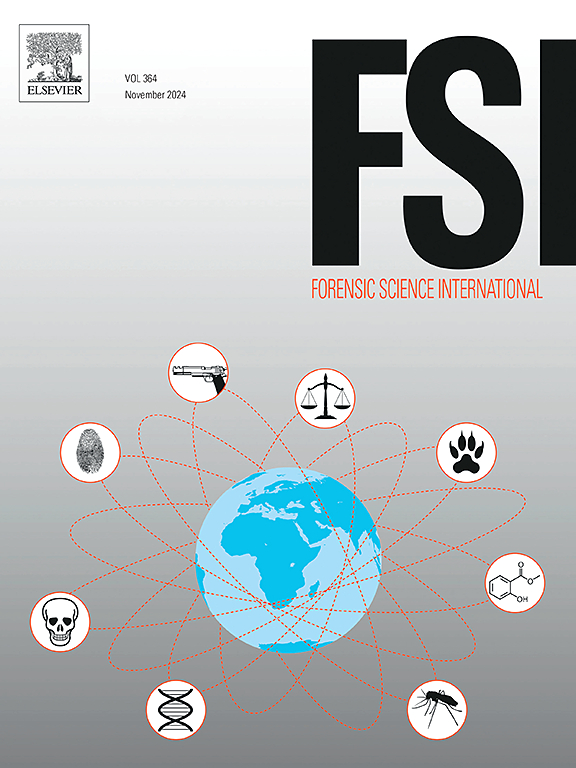增强暗色表面上血迹的可见性:红外摄影检测血迹的特异性和灵敏度
IF 2.5
3区 医学
Q1 MEDICINE, LEGAL
引用次数: 0
摘要
低倍率显微镜和附加光源是法医案件中用于寻找血液的标准工具。这个过程可能很耗时,并且在检查深色表面时,由于血迹和表面之间的对比度较差,可以获得有限的信息。本研究利用佳能XA60红外摄像机研究了红外(IR)摄影在多个黑暗表面上可视化各种血迹的特异性和灵敏度。特异性研究包括对纯血和在个案工作中发现的常见物质(如泥土、铁锈、口红、番茄酱、记号笔、精液、尿液和唾液)的红外成像进行比较。为了检验该技术的灵敏度,血液和水被稀释,以确定红外摄像机的检测限。在被检测的物质中,泥土和铁锈是吸收红外线的物质,看起来与血液相似,但在白光下很容易与血迹区分开来。与其他体液相比,血液是唯一吸收红外线的样本。精液、尿液和唾液反映了红外光谱。红外显像的检出限可达1:10稀释度,偶尔可见1:12稀释度,但这并不一致。进一步的研究表明,暴露在红外辐射下不会影响或导致DNA降解。总之,本研究发现红外摄影是血液搜索以及搜索后增强和记录的有效工具。本文章由计算机程序翻译,如有差异,请以英文原文为准。
Enhancing bloodstain visibility on dark surfaces: Specificity and sensitivity of infrared photography for detecting bloodstains
Low power microscopy and additional light sources are the standard tools used for searching items for blood in forensic casework. This process can be time-consuming and can yield limited information when examining dark surfaces due to poor contrast between bloodstains and the surface. This research investigated the specificity and sensitivity of Infrared (IR) photography in visualising various bloodstains on multiple dark surfaces using the Canon XA60 IR Camcorder. The specificity studies involved the comparison of the IR visualisation of neat blood and common substances found in casework (such as, mud, rust, lipstick, tomato sauce, marker pen, semen, urine, and saliva). To examine the sensitivity of the technique, dilutions of blood and water were created to determine the detection limit of the IR Camcorder. Among the substances tested, mud and rust were found to be absorbers of IR and appeared similar to blood, however they were readily discriminated in white light from bloodstains. In comparison to other body fluids, blood was the only sample that absorbed IR. Semen, urine and saliva reflected the IR. The detection limit of IR visualisation was up to 1:10 dilutions and occasionally 1:12 dilutions were visualised, but this was not consistent. Further studies revealed that exposure to IR does not influence or cause DNA degradation. In conclusion, this study found IR photography to be an efficient tool for blood searching as well as post-search enhancement and documentation.
求助全文
通过发布文献求助,成功后即可免费获取论文全文。
去求助
来源期刊

Forensic science international
医学-医学:法
CiteScore
5.00
自引率
9.10%
发文量
285
审稿时长
49 days
期刊介绍:
Forensic Science International is the flagship journal in the prestigious Forensic Science International family, publishing the most innovative, cutting-edge, and influential contributions across the forensic sciences. Fields include: forensic pathology and histochemistry, chemistry, biochemistry and toxicology, biology, serology, odontology, psychiatry, anthropology, digital forensics, the physical sciences, firearms, and document examination, as well as investigations of value to public health in its broadest sense, and the important marginal area where science and medicine interact with the law.
The journal publishes:
Case Reports
Commentaries
Letters to the Editor
Original Research Papers (Regular Papers)
Rapid Communications
Review Articles
Technical Notes.
 求助内容:
求助内容: 应助结果提醒方式:
应助结果提醒方式:


